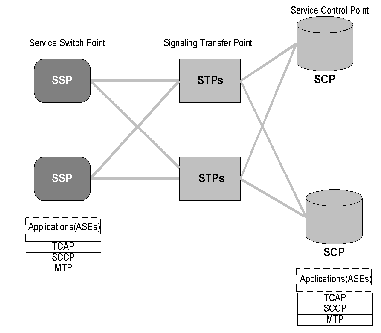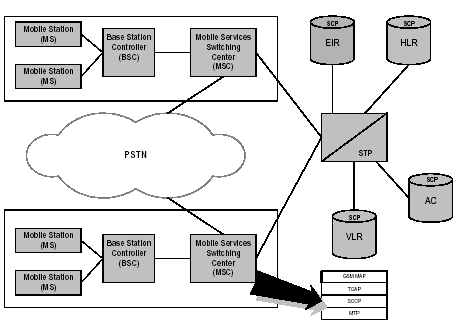
You are here: CSP Developer’s Guide: Common Channel Signaling > 6 SCCP/TCAP > SCCP/TCAP Supports Many Services and Applications
SCCP/TCAP Supports Many Services and Applications

Overview
This section provides examples of the kinds of services and applications that the SCCP/TCAP feature supports.
Assumptions and Dependencies
SCCP software assumes services from SS7 Message Transfer Part (MTP). TCAP software assumes connectionless services from SCCP and services from MTP.
Services enabled by TCAP
The following are some examples of the services enabled by TCAP:
Special Service Number Translation
An SSP uses TCAP to query an SCP to determine the routing number(s) associated with a dialed 800, 888, or 900 number. The SCP uses TCAP to return a response containing the routing number(s) back to the SSP.
Line Interface Database (LIDB) application
Calling card calls are validated and billed using TCAP query and response messages.
Wireless Application
TCAP provides the ability for automatic roaming service by transferring signaling information to remote nodes. When a mobile subscriber roams into a new mobile switching center (MSC) area, the integrated visitor location register (VLR) requests information such as the service profile from the subscriber’s home location register (HLR). In this case, mobile application part (MAP) information is carried within TCAP messages.
TCAP messages are contained within the SCCP portion of a mobile subscriber unit (MSU). An ANSI TCAP message is comprised of a transaction portion and a component portion. In addition, an ITU TCAP (White Book) message contains a dialog portion.
The addition of the SCCP and TCAP layers being integrated into the SS7 solution allows users to provide enhanced calling features, AIN, and wireless applications. The CSP supports ANSI-41 (formerly IS-41) the mobile phone protocol in U.S. networks, which allows wireless roaming. In international networks, the CSP supports the SS7 mobile application part of the Global System for Mobile Communications standard (GSM MAP). GSM MAP supports wireless applications such as Short Message Services (SMS).
The Personal Communications Service (PCS) market specifies the need for the capability to map a hybrid of variants in one stack. The architecture is designed to support this type of hybrid configuration of variants. For example, the ITU TCAP over ANSI SCCP is used for database management in the reallocation of calling traffic.
The CSP can be an integral part of an MSC in a PCS Network Architecture, supplying MTP, SCCP and TCAP in order to support an ANSI-41 (formerly IS-41) application. There can be other applications. The MSC, in a mobile switching center, provides services to the mobile subscriber based on information, such as profile information requested by the integrated VLR from the subscriber’s HLR.
Two examples of applications for SCCP/TCAP are shown next.
SCCP/TCAP Application Scenarios:
Figure 6-2 Intelligent Network Architecture with SCCP/TCAP

Figure 6-3 Personal Communication Service (PCS) Network

User Interface Requirements
The host has access to the TCAP and SCCP layers through the use of the PPL Event Request and PPL Event Indication API messages. Both ITU and ANSI variants of SCCP and TCAP primitives are provided.
The ITU primitives are consistent with the ITU White Book Q.771 SCCP and TCAP specifications.
The ANSI primitives are consistent with ANSI T1.1.114-1992 (TCAP) and ANSI T1.112-1996 (SCCP).